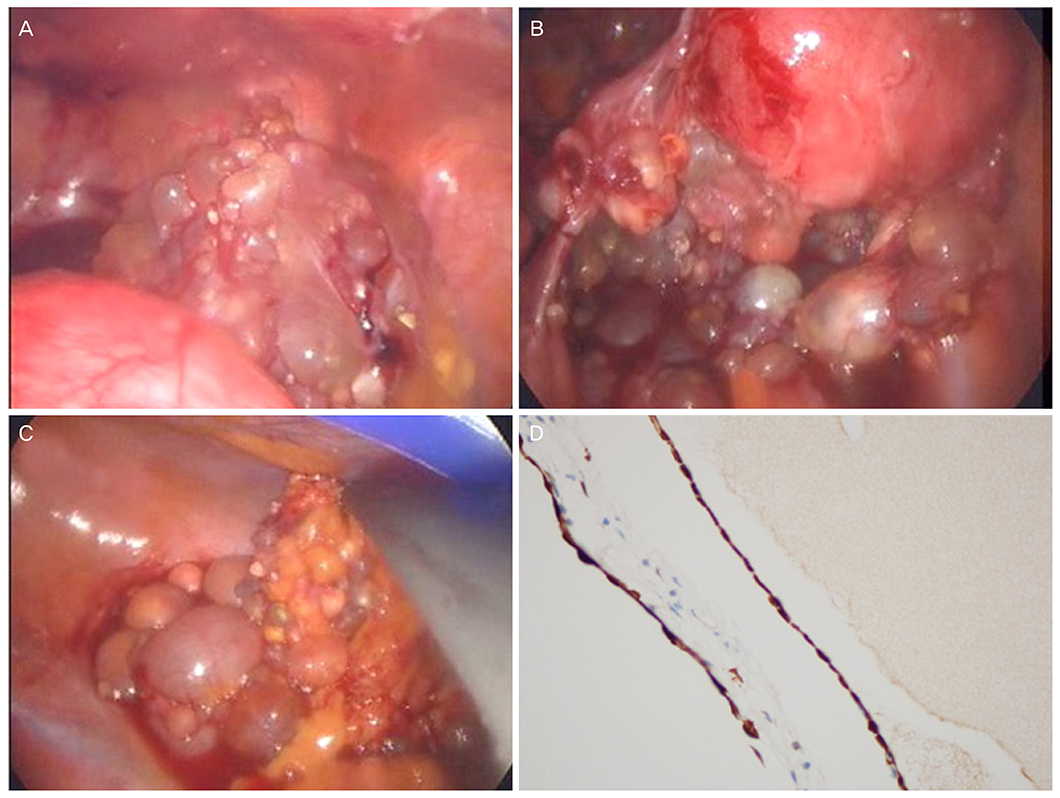Obstet Gynecol Sci.
2018 Jan;61(1):170-174. 10.5468/ogs.2018.61.1.170.
Benign multicystic peritoneal mesothelioma treated with laparoendoscopic single site surgery: a case report and review of the literature
- Affiliations
-
- 1Department of Obstetrics and Gynecology, St. Vincent's Hospital, The Catholic University of Korea College of Medicine, Suwon, Korea.
- 2Department of Obstetrics and Gynecology, Daejeon St. Mary's Hospital, The Catholic University of Korea College of Medicine, Daejeon, Korea. guevara614@catholic.ac.kr
- KMID: 2420168
- DOI: http://doi.org/10.5468/ogs.2018.61.1.170
Abstract
- Benign multicystic peritoneal mesothelioma (BMPM) is rare and difficult to diagnose before surgery. We report a case of BMPM incidentally discovered during laparoendoscopic single site surgery (LESS) for treatment of a pelvic mass. A 47-year-old Korean menopaused woman presented to our outpatient clinic with a pelvic mass. She had a history of right ovary cystectomy with adhesiolysis at a local hospital in 2010. Imaging study of the pelvis revealed a multilocular cystic mass. LESS was performed and multiple grapelike clusters of cysts were seen in the uterus, cul-de-sac, both adnexa, pelvic wall, and omentum. The appendix was grossly free. Frozen biopsy confirmed BMPM. Excision of multiple cyst clusters of cysts, resection of the uterus with both adnexa, appendectomy, omentectomy, and adhesiolysis were performed with LESS. She is well for 2 years with no recurrence. BMPM should be included in the differential diagnosis when small multichamber cystic mass is found on ultrasonography.
Keyword
MeSH Terms
Figure
Reference
-
1. Elbouhaddouti H, Bouassria A, Mouaqit O, Benjelloun B, Ousadden A, Mazaz K, et al. Benign cystic mesothelioma of the peritoneum: a case report and literature review. World J Emerg Surg. 2013; 8:43–48.
Article2. Takemoto S, Kawano R, Honda K, Nakazono A, Shimamatsu K. Benign multicystic peritoneal mesothelioma mimicking recurrence of an ovarian borderline tumor: a case report. J Med Case Reports. 2012; 6:126.
Article3. Momeni M, Pereira E, Grigoryan G, Zakashansky K. Multicystic benign cystic mesothelioma presenting as a pelvic mass. Case Rep Obstet Gynecol. 2014; 2014:852583.
Article4. Cotter TG, Van Arnam JS, Schaffner JA. A case of abdominal discomfort caused by benign multicystic peritoneal mesothelioma. Clin Gastroenterol Hepatol. 2016; 14:e147–e148.
Article5. Shin HD, Kim SB. Benign cystic mesothelioma misdiagnosed as peritoneal carcinomatosis. Case Rep Gastroenterol. 2016; 10:115–120.
Article6. Hong JH, Jeon S, Lee JH, Nam KH, Bae DH. Multicystic benign mesothelioma of the pelvic peritoneum presenting as acute abdominal pain in a young woman. Obstet Gynecol Sci. 2013; 56:126–129.
Article7. Lee R, Tong A, Kurtis B, Gilet AG. Benign multicystic peritoneal mesothelioma: AIRP best cases in radiologic-pathologic correlation. Radiographics. 2016; 36:407–411.8. Khuri S, Gilshtein H, Abboud W, Assalia A, Kluger Y. Benign cystic mesothelioma of the peritoneum: a rare case and review of the literature. Case Rep Oncol. 2012; 5:667–670.
Article9. Tentes AA, Zorbas G, Pallas N, Fiska A. Multicystic peritoneal mesothelioma. Am J Case Rep. 2012; 13:262–264.10. Jouvin I, Dohan A, Gergi P, Pocard M. Intra-abdominal benign multicystic peritoneal mesothelioma. J Visc Surg. 2014; 151:155–157.
Article11. González-Moreno S, Yan H, Alcorn KW, Sugarbaker PH. Malignant transformation of “benign” cystic mesothelioma of the peritoneum. J Surg Oncol. 2002; 79:243–251.
Article12. Yang YS, Oh KY, Hur MH, Kim SY, Yim HS. Laparoendoscopic single-site surgery using conventional laparoscopic instruments and glove port technique in gynecology: a single surgeon’s experience. J Minim Invasive Gynecol. 2015; 22:87–93.
Article13. Boruta DM. Laparoendoscopic single-site surgery in gynecologic oncology: an update. Gynecol Oncol. 2016; 141:616–623.
Article14. Pontis A, Sedda F, Mereu L, Podda M, Melis GB, Pisanu A, et al. Review and meta-analysis of prospective randomized controlled trials (RCTs) comparing laparo-endoscopic single site and multiport laparoscopy in gynecologic operative procedures. Arch Gynecol Obstet. 2016; 294:567–577.
Article15. Jeung IC, Lee YS, Song MJ, Park EK. Single-site total laparoscopic hysterectomy: clinical factors that affect operative times and techniques to overcome difficulties. J Minim Invasive Gynecol. 2017; 24:617–625.



